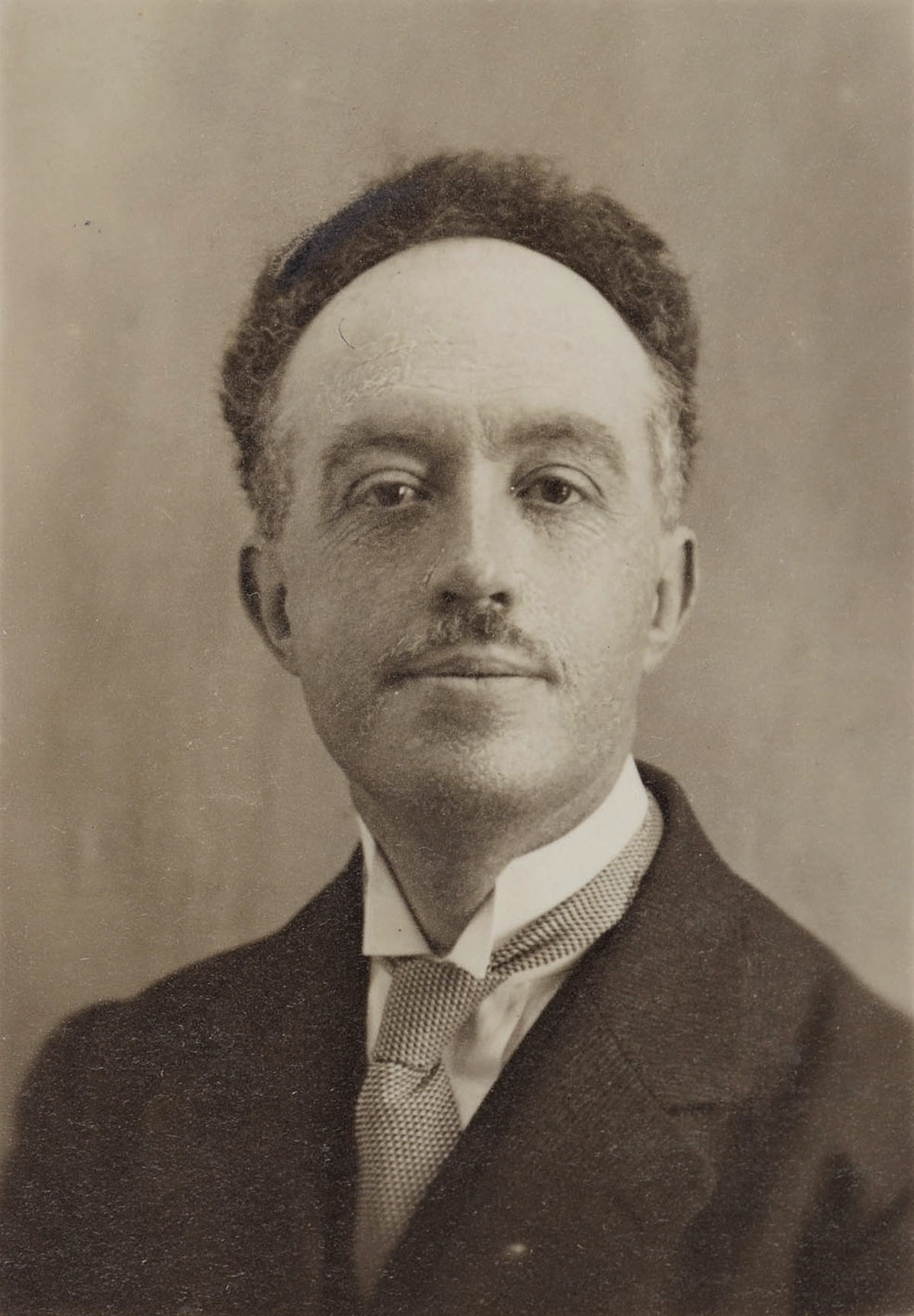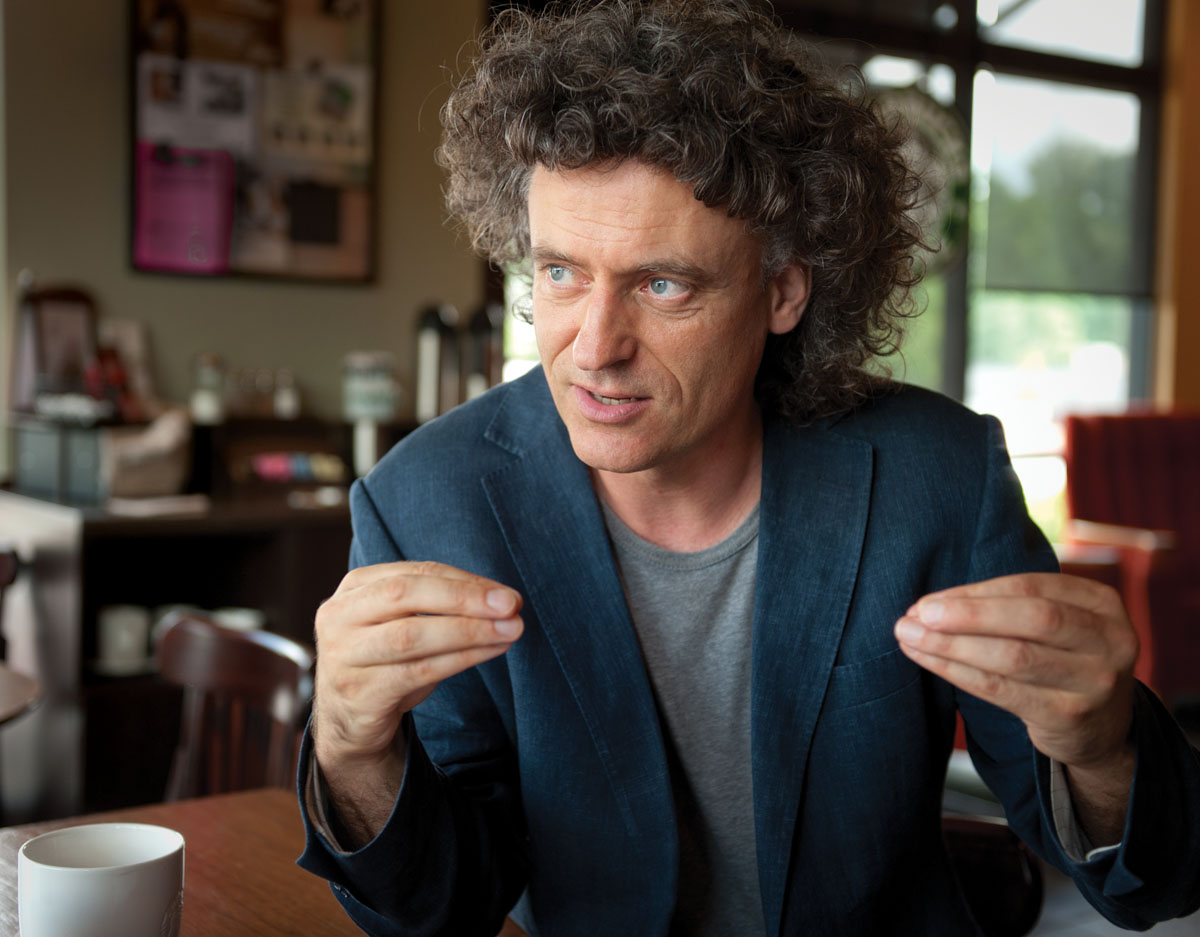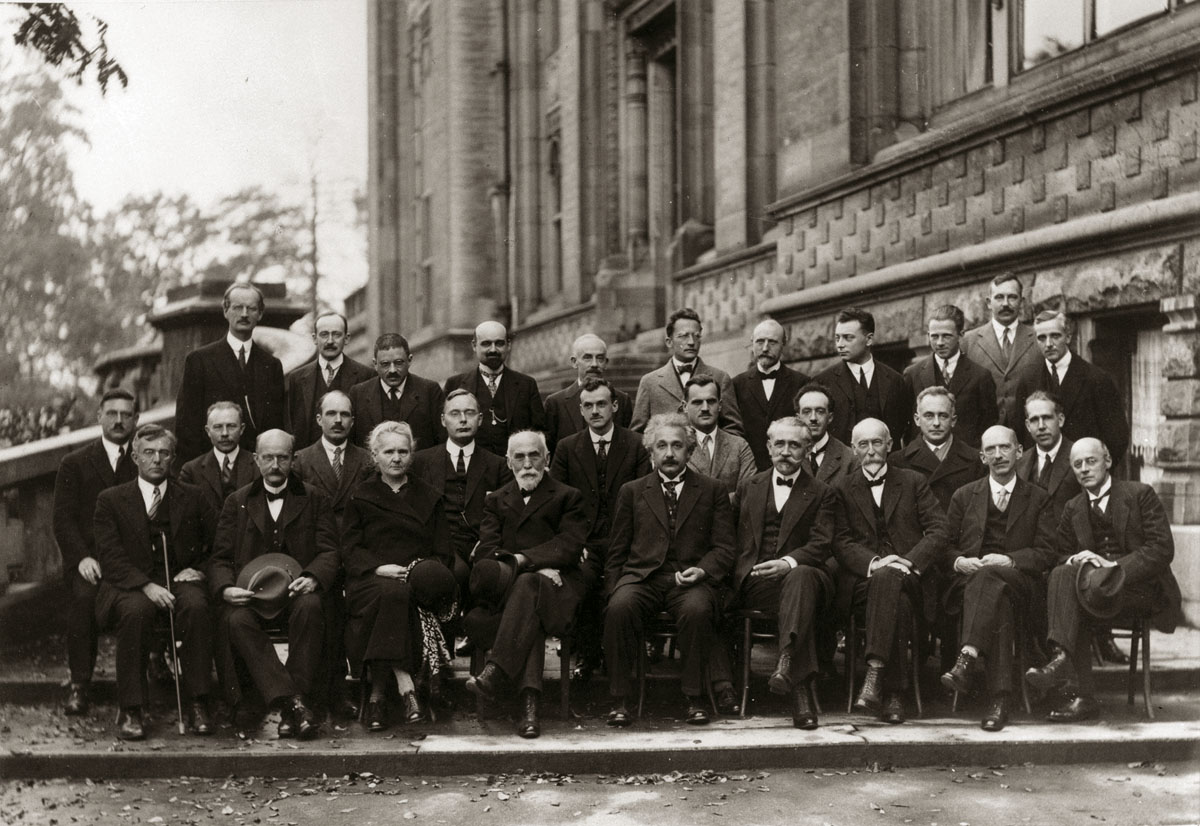quantum heretic
Jemma Everyhope-Roser
Antony Valentini to quantum physics: Get real.
In the warm winter sunshine, a distinguished man stands on the curb outside a local bank, wearing a casual jacket, his dark, curly hair stranded with silver. He watches with fascination as a taxi driver demonstrates how to fling a poisonous snake off into the grass using a stick. Antony Valentini shakes his head a little and wonders, aloud, if anyone would believe him back home. Poisonous snakes are foreign to him—as foreign as the big black king snake he found sunbathing in his back yard.
Valentini was raised in London, where his Italian parents still live. He has lived and worked in Italy, Austria, France, and Canada, among others. Accustomed to public transportation, he doesn’t drive, and he’s struck up a friendship with the taxi driver who drops him off every morning in town. After breakfast at the Pot Belly Deli, Valentini usually ambles across the street to Starbucks.
“I’m addicted to their tea,” he explains.
With a mug of Earl Grey in hand, Valentini sits down at a small table with his back to the windows. He removes a pencil and a notepad from his Italian leather briefcase. He carries this hardbound notebook everywhere, in case an idea strikes him.
But this morning, he isn’t jotting down new ideas. He has a stack of printouts from his book with him so that he can review it a page at a time.
“I like having a buzz around me,” he says. That’s why he works here at Starbucks, reviewing his final draft. About eight hundred pages long, the book is a summation of his work—a systematic rejection of the foundations of one of the longest and strongest-held theories in all of science. At Cambridge, he started out studying standard quantum mechanics; it’s what physicists are taught. But to him, it just didn’t make any sense. He remembers thinking, “But how can we understand this?”
an underdog theory
At Solvay, de Broglie lost, but did physics win?
You’ve probably heard of string theory, standard quantum mechanics, and general relativity. But pilot wave? No, never heard of that. The reason why goes back to the theory’s history. Antony Valentini wrote about this (and other things) in the book he coauthored, Quantum Theory at the Crossroads: Reconsidering the 1927 Solvay Conference.
This story begins in the early twentieth century, a time of revolutionary advancements in physics, at the Solvay Conferences in Brussels, Belgium. Some of the best and brightest minds attended these conferences: Einstein, Marie Curie, Heisenberg, Schrödinger, and Planck, to name a few.
Louis de Broglie was also there. He was from Paris, then something of a backwater in theoretical physics. His theory, presented at the 1927 conference, was well regarded by figures like Einstein and Schrödinger (who adapted it but threw out the particle aspect in his famous equation).
But de Broglie’s theory wasn’t widely read. That’s because it was in French. Louis de Broglie was an isolated francophone in a world of high-powered Germanic physicists. In the end, Bohr and Heisenberg won the day. At the Fifth Solvay Conference in 1927, physicists met and debated quantum theory. It wasn’t exactly a popularity contest.
But what ended up happening was a “victory” for standard quantum mechanics, also known as Copenhagen quantum mechanics. After that, all other approaches were just seen as, well, wrong.
For all that, de Broglie went on to win the Nobel Prize in physics in 1929.
Sparking new thought
Now, fast forward. It was after World War II and de Broglie’s work had fallen into obscurity. A young assistant professor named David Bohm started employment at Princeton University’s Institute of Advanced Study. Coincidentally, that was also where Albert Einstein worked. So, when Bohm published a book in 1951 defending standard quantum mechanics, Einstein criticized it. Apparently that sparked a new line of thought in Bohm, because he ended up developing de Broglie’s partial proof and demonstrating that pilot-wave theory was completely equivalent to standard quantum mechanics. But the story doesn’t end here.

Louis de Broglie won the Nobel Prize, but his theory was not widely read. Image courtesy of the Leopoldina National Academy.
Around this time, McCarthyism was burning across the country. And David Bohm, when working on his Ph.D. thesis at Berkeley under Oppenheimer, had dabbled in communism. He was recommended for and then denied access to the Manhattan Project. He was brought up to hearings again and again. When he received an invitation to work at the University of São Paulo in Brazil, he took it and got out of the country. His work was further discredited when he later turned to mysticism.
For years, most physicists didn’t know about the theory or thought, vaguely, that it had been proven wrong. The few scientific papers that were written about pilot-wave theory dismissed de Broglie’s approach as just plain wrong and Bohm as a kooky communist.
But in the ‘80s, many physicists began to question standard quantum mechanics. The theory had problems, unanswerable questions, and just didn’t make sense. In those days, Valentini says, people were defending quantum mechanics by saying things like: “It’s meaningless to ask such questions,” and “I don’t believe any other theory can be true.” But in the last fifteen years, majority opinion began to change as pilot-wave theory became accepted as a legitimate theory. The criticism changed to: “Well, if it is equivalent experimentally, what’s the point in studying it then?” John Bell, after spending a year’s leave from CERN at Stanford, wrote a paper that arguably came out in favor of the de Broglie-Bohm pilot-wave theory. This paper was what prompted Antony Valentini to look for real answers to the big questions in physics.
A strange conspiracy
In standard quantum mechanics, one particle’s motion can be correlated to another’s, even if they’re distant and unrelated. So it seems like the particles are “communicating” at faster-than-light speeds.
Valentini shakes his head and says, “This looked like some kind of strange conspiracy. It’s as if there’s something going on, faster than light, beneath the surface, but you can’t get your hands on it directly and use it to send signals. If there really are faster-than-light influences, why can’t we use them? It’s as if the laws of physics are conspiring to hide something.”
One of the reasons “quantum” sounds so mysterious to non-physicists is that, according to standard quantum mechanics, any given particle may or may not exist, or may be anywhere in a sliding scale of existence. But that makes no sense on the macroscopic level, in the world we observe every day.
“If you’re holding a cup,” Valentini says, hefting up his white ceramic mug of tea, “it’s not going to vanish. It’s there. If atoms don’t have definite physical states, then how can this cup exist?”
In standard quantum mechanics, Antony explains, “On the microscopic realm, there’s no definite reality, and in the macroscopic realm, there is.” He taps the brown-varnished table, demonstrating its physical reality. “So standard quantum mechanics is ultimately ambiguous, because there’s no precise boundary between these two realms.”
This is a part of what’s known as the measurement problem because it usually comes up during experiments, when physicists are attempting to measure particles. The question always becomes, “Did that particle exist in this way before we observed and measured it?” The term is actually a misnomer, Valentini explains, for what should really be called the reality problem.
Standard quantum mechanics is what Valentini calls “a dirty theory” because you can use it and get accurate results, but you can’t understand it. “Why should the world be like that?” he remembers thinking. “There had to be an explanation.”
When Valentini encountered the de Broglie-Bohm pilot-wave theory, he says, “It gave a beautiful explanation for this conspiracy.”
The basis of pilot-wave theory is particles are guided (or piloted) by a wave. You can imagine this by picturing driftwood riding a wave. If you have a bottle on the same wave, the debris would wash toward the shore together, almost as if it were one.
Of course, this metaphor only goes so far. According to pilot-wave theory, this debris would actually be a single higher-dimensional object. When you get what looks like multiple particles riding the wave as one object, there are faster-than-light effects. But you don’t have to explain them away with that state of “indefinite reality” like in quantum mechanics. There’s a definite reality here. Essentially, in pilot-wave theory, the measurement problem isn’t even a problem at all.
“It gave a precise hypothetical account of the world,” Valentini says.
A law that isn’t
Pilot-wave theory has three axioms. The first is de Broglie’s law of motion, which specifies exactly how particles are guided by the wave. The second is Schrödinger’s wave equation, telling us how the wave itself changes over time. The third is that particles have to start off with a certain probability distribution.
“In any given experiment, each particle is accompanied by a wave. The particle starts off somewhere inside the wave. If I repeat the experiment, the particles sometimes start here, or there, or there, or there,” he says, indicating points in the air with his pen. “If I repeat the experiment many times, they start out with a distribution that is proportional to the square of the height of the wave.”
In order to give results that can be verified with an experiment, all three axioms have to be used. But the third axiom gave Valentini pause. It didn’t sound like a law describing how things work. It sounded like an input, like data.
Valentini pondered this. Then he posed his own explanation: This input is like a law because all of the particles we use in experiments always start out with that probability distribution.
But maybe, he says, the particles don’t always have to start out like that. Think of shaking a box of pennies. If you shake it enough, you’ll get an even heads-to-tails distribution. That’s sort of what’s happened to the universe. It’s been around for a while. It’s been shaken up. The particles have reached an even distribution, or close enough.
But what if those starting conditions changed? What if the distribution wasn’t always like that? If you go back far enough, right back to the beginning of the universe, then you might get really different conditions. You could be talking about a physics that describes the early convulsions of the universe, the big bang itself. This would also answer a question that other physicists ask Valentini a lot, which is: “If standard quantum mechanics and pilot-wave theory provide the same experimental results, then why study pilot wave at all?”
Because these two theories may not describe the same physics. Because, if the conditions were different in the beginning of the universe, maybe only pilot-wave theory can describe the big bang.
“Now,” Valentini says, “how can we test that?”
The universe as a lab
The experimental lab is all around us—it’s the universe itself. The universe started out as homogenous, a smooth and even distribution. But now, clumps of galaxies are divided by vast swathes of nothingness. How did that happen?
Cosmology actually does have a good understanding of that. In the very beginning, the universe was smooth—but it wasn’t perfectly, uniformly smooth. There were tiny lumps. Each region of space that was slightly lumpier, slightly thicker, exerted more gravitational pull. It attracted other matter to itself, and the more matter it attracted, the more it could attract. And eventually you got galaxies, nebulas, solar systems, suns, and planets. What’s not understood about this process is this: Why didn’t the matter start out as perfectly, evenly distributed? What seeded the formation of galaxies, of structure in the universe?
“In the nineteen-eighties, there was a theory developed called inflationary cosmology,” Valentini explains. “It is by now the leading candidate for what happened in the beginning of the universe. The reason why it’s called ‘inflation’ is because, in this theory, the universe went through a period of exponential expansion very early on.”
People began to calculate, using quantum mechanics, what would happen on an exponentially expanding space—and they found fluctuations that could explain the non-uniformity of the universe. “Basically,” Valentini says, “these fluctuations in turn trace back to the third axiom.”
It seems impossible to gather data about what happened fourteen billion years ago, in the universe’s first fraction of a second, but Valentini says, confidently, “There is a way.”
Data from space
It’s called the cosmic microwave background. A relic of the big bang, this is background radiation that provides a snapshot of the past. It shows what cosmology knows must have been true: small ripples, the slight non-uniformities that led to what we see in the skies today.
As we point more satellites at deep space, we get more information on what cosmic radiation actually looks like. Valentini believes he may be able to use this information to show something: that the third axiom is wrong, that particles don’t always have to have this starting point distribution. If that’s the case, then we should see anomalies in this cosmic background radiation.
And anomalies have been reported.
But these anomalies are controversial and they may not even be statistically significant. The data we have are from the old WMAP satellite, which is not as precise as it could be. Valentini needs the new data coming from the Planck satellite. With its next-generation instruments, the Planck will provide data that are more precise than ever before.
But before the Planck satellite’s data can be released, the data must be “cleaned.” Starting with the satellite’s readings, scientists will use complex calculations to subtract our galaxy’s background noise, instrumental noise, and instrumental errors. Only then will they release the cleaned data—and this should happen within the year.
“There are some hints in the data on large scales,” Valentini says. “I hope this will be clarified by the new data from the Planck satellite. But in the meantime there is some work that needs to be done to make my predictions more precise.” Valentini wants to use the Palmetto Cluster—the university’s supercomputer—to run complex computer simulations of the early universe. If he can accurately predict anomalies shown in the Planck satellite’s data, he’ll have solid evidence supporting pilot-wave theory. If pilot wave could describe what standard quantum mechanics cannot, that would have huge ramifications in the physics world.
Antony Valentini sips his tea from a mug that is as undeniably real as the busy coffee shop around him. If he’s right, then we may have a whole new way to understand how the universe works.
Antony Valentini is a professor of theoretical quantum physics in the Department of Physics and Astronomy at the College of Engineering and Science. His work is funded jointly by Clemson University and the John Templeton Foundation.




